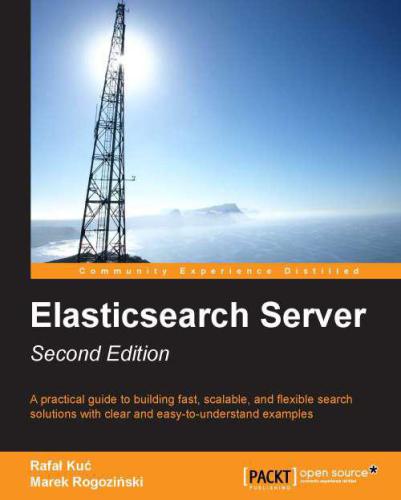Product desciption
Elasticsearch Server 2nd Edition Rafa Ku Marek Rogoziski by Rafał Kuć, Marek Rogoziński instant download after payment.
Overview
Learn about the fascinating functionalities of ElasticSearch like data indexing, data analysis, and dynamic mapping
Fine-tune ElasticSearch and understand its metrics using its API and available tools, and see how it behaves in complex searches
A hands-on tutorial that walks you through all the features of ElasticSearch in an easy-to-understand way, with examples that will help you become an expert in no time
In Detail
This book begins by introducing the most commonly used Elasticsearch server functionalities, from creating your own index structure, through querying, faceting, and aggregations, and ends with cluster monitoring and problem diagnosis. As you progress through the book, you will cover topics such as starting Elasticsearch, creating a new index, and designing its proper structure. After that, youll read about the query API that Elasticsearch exposes, as well as about filtering capabilities, aggregations, and faceting. Last but not least, you will get to know how to find similar documents by using similar functionalities and how to implement application alerts by using the prospective search functionality called percolator. Some advanced topics such as shard allocation control, gateway configuration, and how to use the discovery module will also be discussed. This book will also show you the possibilities of cluster state and health monitoring as well as how to use third-party tools.
What you will learn from this book
Configure and create your own index
Set up an analysis chain and handle multilingual data
Use the Elasticsearch query DSL to make all kinds of queries
Utilize filters efficiently and ensure they do not affect performance
Implement autocomplete functionality
Employ faceting, the aggregations framework, and similar functionalities to get more from your search and improve your clients search experience
Monitor your cluster state and health by using Elasticsearch APIs as well as third-party monitoring solutions
Learn what gateway and discovery modules are, and how to properly configure them
Control primary shards and replica rebalancing
A practical guide to building fast, scalable, and flexible search solutions with clear and easy-to-understand examples
Overview
Learn about the fascinating functionalities of ElasticSearch like data indexing, data analysis, and dynamic mapping
Fine-tune ElasticSearch and understand its metrics using its API and available tools, and see how it behaves in complex searches
A hands-on tutorial that walks you through all the features of ElasticSearch in an easy-to-understand way, with examples that will help you become an expert in no time
In Detail
This book begins by introducing the most commonly used Elasticsearch server functionalities, from creating your own index structure, through querying, faceting, and aggregations, and ends with cluster monitoring and problem diagnosis. As you progress through the book, you will cover topics such as starting Elasticsearch, creating a new index, and designing its proper structure. After that, youll read about the query API that Elasticsearch exposes, as well as about filtering capabilities, aggregations, and faceting. Last but not least, you will get to know how to find similar documents by using similar functionalities and how to implement application alerts by using the prospective search functionality called percolator. Some advanced topics such as shard allocation control, gateway configuration, and how to use the discovery module will also be discussed. This book will also show you the possibilities of cluster state and health monitoring as well as how to use third-party tools.
What you will learn from this book
Configure and create your own index
Set up an analysis chain and handle multilingual data
Use the Elasticsearch query DSL to make all kinds of queries
Utilize filters efficiently and ensure they do not affect performance
Implement autocomplete functionality
Employ faceting, the aggregations framework, and similar functionalities to get more from your search and improve your clients search experience
Monitor your cluster state and health by using Elasticsearch APIs as well as third-party monitoring solutions
Learn what gateway and discovery modules are, and how to properly configure them
Control primary shards and replica rebalancing
Approach
This book is a detailed, practical, hands-on guide packed with real-life scenarios and examples which will show you how to implement an ElasticSearch search engine on your own websites


